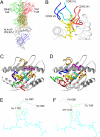Rational development of high-affinity T-cell receptor-like antibodies
- PMID: 19307587
- PMCID: PMC2667008
- DOI: 10.1073/pnas.0901425106
Rational development of high-affinity T-cell receptor-like antibodies
Erratum in
- Proc Natl Acad Sci U S A. 2009 Jun 30;106(26):10872. Nuber, Natko [added]
Abstract
T-cell interaction with a target cell is a key event in the adaptive immune response and primarily driven by T-cell receptor (TCR) recognition of peptide-MHC (pMHC) complexes. TCR avidity for a given pMHC is determined by number of MHC molecules, availability of coreceptors, and TCR affinity for MHC or peptide, respectively, with peptide recognition being the most important factor to confer target specificity. Here we present high-resolution crystal structures of 2 Fab antibodies in complex with the immunodominant NY-ESO-1(157-165) peptide analogue (SLLMWITQV) presented by HLA-A*0201 and compare them with a TCR recognizing the same pMHC. Binding to the central methionine-tryptophan peptide motif and orientation of binding were almost identical for Fabs and TCR. As the MW "peg" dominates the contacts between Fab and peptide, we estimated the contributions of individual amino acids between the Fab and peptide to provide the rational basis for a peptide-focused second-generation, high-affinity antibody library. The final Fab candidate achieved better peptide binding by 2 light-chain mutations, giving a 20-fold affinity improvement to 2-4 nM, exceeding the affinity of the TCR by 1,000-fold. The high-affinity Fab when grafted as recombinant TCR on T cells conferred specific killing of HLA-A*0201/NY-ESO-1(157-165) target cells. In summary, we prove that affinity maturation of antibodies mimicking a TCR is possible and provide a strategy for engineering high-affinity antibodies that can be used in targeting specific pMHC complexes for diagnostic and therapeutic purposes.
Conflict of interest statement
The authors declare no conflict of interest.
Figures




Similar articles
-
Fab antibodies capable of blocking T cells by competitive binding have the identical specificity but a higher affinity to the MHC-peptide-complex than the T cell receptor.Immunol Lett. 2009 Aug 15;125(2):86-92. doi: 10.1016/j.imlet.2009.06.002. Epub 2009 Jun 12. Immunol Lett. 2009. PMID: 19524620
-
TCR-like human antibodies expressed on human CTLs mediate antibody affinity-dependent cytolytic activity.J Immunol. 2002 Jul 15;169(2):1110-8. doi: 10.4049/jimmunol.169.2.1110. J Immunol. 2002. PMID: 12097420
-
Probing the Conformational Dynamics of Affinity-Enhanced T Cell Receptor Variants upon Binding the Peptide-Bound Major Histocompatibility Complex by Hydrogen/Deuterium Exchange Mass Spectrometry.Biochemistry. 2021 Mar 23;60(11):859-872. doi: 10.1021/acs.biochem.1c00035. Epub 2021 Mar 9. Biochemistry. 2021. PMID: 33689297
-
Recombinant antibodies with MHC-restricted, peptide-specific, T-cell receptor-like specificity: new tools to study antigen presentation and TCR-peptide-MHC interactions.J Mol Recognit. 2003 Sep-Oct;16(5):324-32. doi: 10.1002/jmr.640. J Mol Recognit. 2003. PMID: 14523945 Review.
-
The Quest for the Best: How TCR Affinity, Avidity, and Functional Avidity Affect TCR-Engineered T-Cell Antitumor Responses.Cells. 2020 Jul 18;9(7):1720. doi: 10.3390/cells9071720. Cells. 2020. PMID: 32708366 Free PMC article. Review.
Cited by
-
Treatment with 5-Aza-2'-Deoxycytidine Induces Expression of NY-ESO-1 and Facilitates Cytotoxic T Lymphocyte-Mediated Tumor Cell Killing.PLoS One. 2015 Oct 8;10(10):e0139221. doi: 10.1371/journal.pone.0139221. eCollection 2015. PLoS One. 2015. PMID: 26447882 Free PMC article.
-
TCR-like CARs and TCR-CARs targeting neoepitopes: an emerging potential.Cancer Gene Ther. 2021 Jun;28(6):581-589. doi: 10.1038/s41417-021-00307-7. Epub 2021 Mar 2. Cancer Gene Ther. 2021. PMID: 33654227 Free PMC article. Review.
-
Re-directed T cells for the treatment of fibroblast activation protein (FAP)-positive malignant pleural mesothelioma (FAPME-1).BMC Cancer. 2012 Dec 22;12:615. doi: 10.1186/1471-2407-12-615. BMC Cancer. 2012. PMID: 23259649 Free PMC article. Clinical Trial.
-
T cell receptor-like recognition of tumor in vivo by synthetic antibody fragment.PLoS One. 2012;7(8):e43746. doi: 10.1371/journal.pone.0043746. Epub 2012 Aug 20. PLoS One. 2012. PMID: 22916301 Free PMC article.
-
An old Twist in HLA-A: CDR3α Hook up at an R65-joint.Front Immunol. 2015 May 27;6:268. doi: 10.3389/fimmu.2015.00268. eCollection 2015. Front Immunol. 2015. PMID: 26074926 Free PMC article. Review.
References
-
- Mak TW. The T cell antigen receptor: “The Hunting of the Snark.”. Eur J Immunol. 2007;37(Suppl 1):S83–S93. - PubMed
-
- Konig R. Interactions between MHC molecules and co-receptors of the TCR. Curr Opin Immunol. 2002;14(1):75–83. - PubMed
-
- Holler PD, Chlewicki LK, Kranz DM. TCRs with high affinity for foreign pMHC show self-reactivity. Nat Immunol. 2003;4(1):55–62. - PubMed
Publication types
MeSH terms
Substances
Associated data
- Actions
- Actions
- Actions
Grants and funding
LinkOut - more resources
Full Text Sources
Other Literature Sources
Molecular Biology Databases
Research Materials

